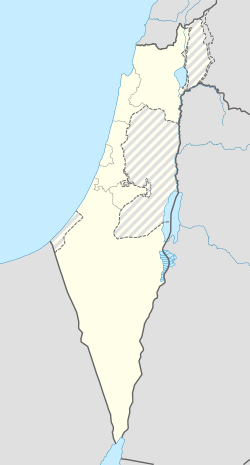Top Qs
Timeline
Chat
Perspective
Fassuta
Christian Arab village in Israel From Wikipedia, the free encyclopedia
Remove ads
Fassuta (Arabic: فسوطة, Hebrew: פסוטה) is a Christian Arab local council in the Northern District of Israel. It is located in the Upper Galilee on the northwestern slopes of Mount Meron, south of the Lebanese border.[3] In 2023 it had a population of 3,387, nearly all of whom are Melkite Christian Arabs.[1][4] In 2022, 99.8% of the population was Christian and 0.2% was Muslim.[5]
Remove ads
History
Summarize
Perspective
Archaeological excavations at Fassuta have revealed settlement from the Early Bronze Age, through the Iron Age, Hellenistic and the Mamluk eras.[6][7][8][9]
From approximately 70 CE to 450 CE, Fassuta was the site of a Jewish town called Mafsheta. [10] Mafsheta is associated with one of the twenty-four priestly divisions, as the residence of the priestly clan known as Harim.[11]
In the Crusader era Fassuta was known as Fassove.[12][13] In 1183, Godfrey de Tor sold the village land to Joscelin III.[13] In 1220 Jocelyn III's daughter Beatrix de Courtenay and her husband Otto von Botenlauben, Count of Henneberg, sold their land, including Fassove, to the Teutonic Knights.[14][15]
Ottoman Empire
In 1517, Fassuta was incorporated into the Ottoman Empire. In the 1596 tax records it was part of the Nahiya of Akka of the Safad Sanjak and had a population of 12 Muslim households and 3 Muslim bachelors. The villagers paid a fixed tax-rate of 20% on wheat, barley, fruit trees, and goats or beehives.[16]
In 1838 Fesutha was described as a Christian and Druze village in the El-Jebel district, west of Safed.[17]
In 1875, Victor Guérin found "twenty united Greek families" living in the village which had been built on an ancient site, of which there were many remains.[18]
In 1881, the PEF's "Survey of Western Palestine" (SWP) described Fassuta as "a village, built of stone, containing about 200 Christians, situated on ridge, with gardens of figs, olives, and arable land. There are two cisterns in the village, and a good spring near."[19]
According to a population list from 1887, there were 570 inhabitants.[20]
British Mandate

At the time of the 1922 census of Palestine conducted by the British Mandate, Fassuta had a population of 459: 444 Christians and 15 Muslims.[21] The Christians included 1 Orthodox Christian, 18 Syrian Orthodox, and 425 Melkites.[22] In the 1931 census, the combined population of Fassuta and Mansura was 507 Palestinian Christians and 81 Muslims, living in a total of 129 houses.[23]
In the 1945 statistics Fassuta had 1,050 inhabitants.[24][25] The combined population of Fassuta, Al-Mansura and Dayr al-Qasi was 2,300, and their total land area was 34,011 dunums.[25][26] 1,607 dunams were plantations and irrigable land, 6,475 used for cereals,[27] while 247 dunams were built-up (urban) land.[28] Between 1922 and 1947, the population of Fassuta increased by 120%.[29]
Israel
At the end of October 1948, during Operation Hiram, the village was captured by the Israeli army. Most of the Muslims fled or were expelled but many Christians remained. In December 1949 the Israel Defense Forces devised a plan to create a 5–10 km Arab-free zone along the Lebanon border by ordering those who remained in Fassuta and five other villages to leave. However, the plan was rejected, [30]and the village remained under martial Law until 1966.
In April 2023, a resident of Fassuta was injured in a rocket attack from Lebanon attributed to the militant group Hamas.[31][32]
Remove ads
Demographics

In 2005, Fassuta had a population of 2,900, with an annual population growth rate of 0.9%. All were Christian Arabs of the Melkite (Greek) Catholic Church.[4][33]
In 2022, the village had a population of 3,255 people, of which 99.7% of them were Arabs and the 0.3% were other ethnicities.[1] Fassuta does not have a Jewish population.[1]
Religion and culture
The Mar Elias Church in Fassuta celebrated its 100th anniversary in 2007. The church is named for Elias, the village's patron saint. A large statue of Elijah stands in the central square.[3]
Beit Rima is a center for culture, tourism and art established in a historic home in Fassuta.[34]
Archaeology

In 1875, Victor Guérin found "numerous cisterns, a great reservoir, vestiges of many ruined houses, fine cut stones marking out floors, and a dozen of winepresses nearly perfect. These winepresses are all on the same model. Worked in the rock, they consisted of two compartments, one larger, in which the grapes were placed, and one smaller and lower down, in which the juice was received." In the church Guerin saw a Corinthian pillar, probably Byzantine, carved with a cross. Above the door was a frieze finely decorated with flowers and foliage.[35]
Remove ads
Notable people
See also
References
Bibliography
External links
Wikiwand - on
Seamless Wikipedia browsing. On steroids.
Remove ads



